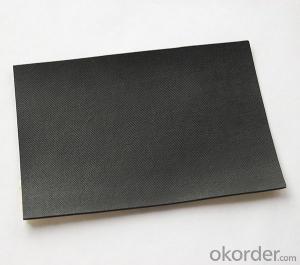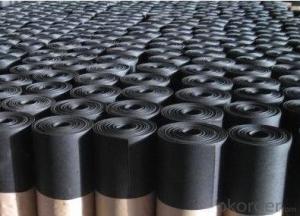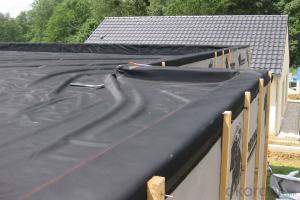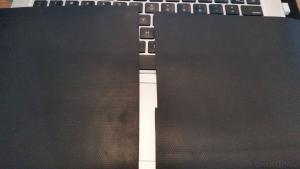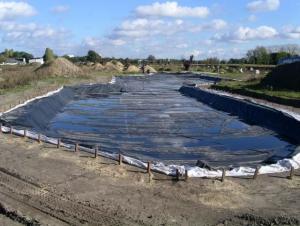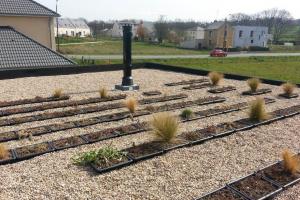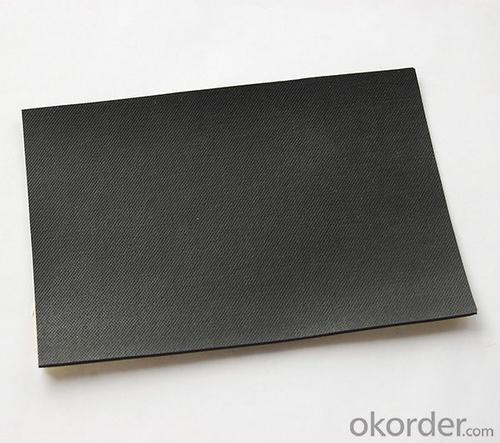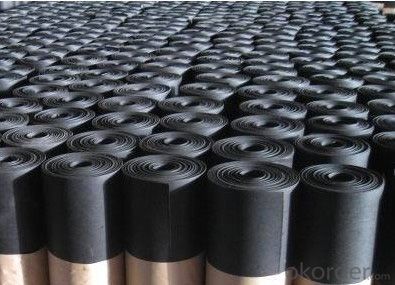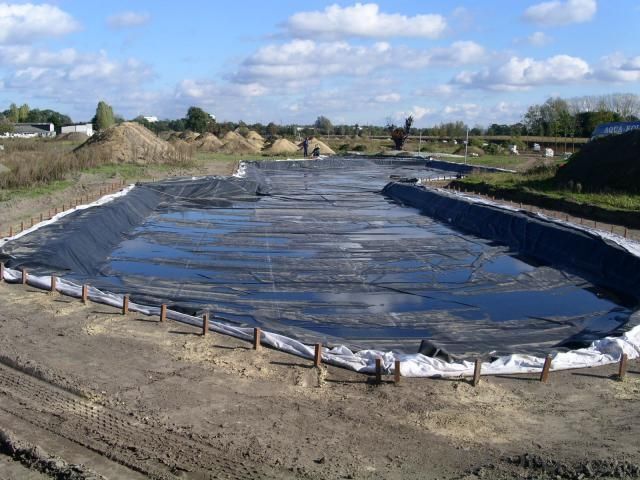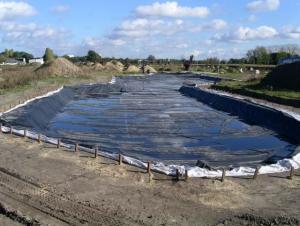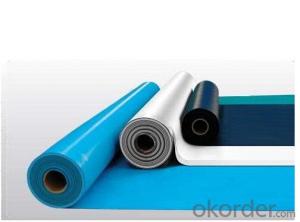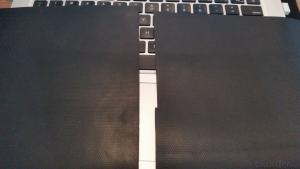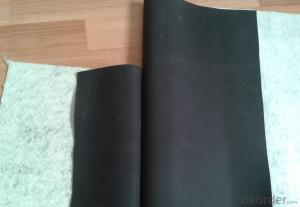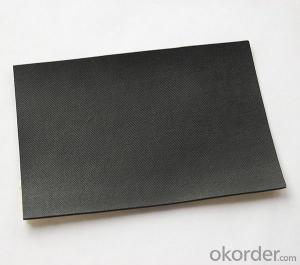EPDM Rubber Waterproof Membrane with Fabric Surface
- Loading Port:
- Shanghai
- Payment Terms:
- TT OR LC
- Min Order Qty:
- 50000 m²
- Supply Capability:
- 5000000 m²/month
OKorder Service Pledge
OKorder Financial Service
You Might Also Like
EPDM Rubber Waterproof Membrane with Fabric Surface
Description Of EPDM Rubber Waterproof Membrane with Fabric Surface:
EPDM is of high elasticity with best performance among high polymer waterproof coiled material in the world.It is alsothe most typical one in the world.Waterproof coiled material made of ternary ethylene-propylene rubber. It is good in compactness,without bubble and performance difference in length and breadth,performances reach or exceed the demands of GB18173.1-2012 standard.
Main Features of EPDM Rubber Waterproof Membrane with Fabric Surface:
1. Excellent antiaging performance, service life up to 50 years
2. Working well with in 40C to 100C,it canbe constructed with a single layer in ambient temperature.
3. Waterproofing on various kinds of underground project,industrial of civil buildings and structures.
4. high extension rate, high tensile strength, small size changes at heat treatment
5. Good plant roots penetrability resistance and can be made waterproofing layer of planting roof
6. Special modified molecular structure ,effectively resolving the current domestic and foreign glue joint problem . 7. Good low temperature flexibility, and good performance of adapting to ambient temperature changes. 8. Convenient application ,solid joint, no environment pollution
9. chemical corrosion Resistance, can be used for special occasions
10. Convenient maitenance, low cost.
Specifications of EPDM Rubber Waterproof Membrane with Fabric Surface:
| Material | EPDM Rubber |
| Size | 1.2m (width)*20m (length) or customized, weldable type 2.05m or 4m width |
| Thick | 1.2mm, 1.5mm, 2.0mm |
| Type | Vulcanized & Weldable |
| Pattern | Non-reinforced (homogeneous) |
| Certificate | ISO9001/14001 |
Applications of EPDM Rubber Waterproof Membrane with Fabric Surface:
1. The substratum should be smooth, dry, clean, which can not have loosing and peeling phenomena.
2. Before application, clean up the basic level and eradicate the impurities.
3. Spread out the membrane on the substratum to loose sheet's stress. Use adhesive-glue to paint the substratum and the surface of membrane. When the adhesive is not sticky to hands, pave and press smoothly.
4. Widely used in roofs, basement, toilet ,swimming pool, and all kinds of industry and civil building waterproofing, reservoir, vivicism, bridge, underground, tunnel and dam waterproofing ,especially to the keystone waterproofing projects which is durability, high corrosion resistance and easy
deformation.



IMages of EPDM Rubber Waterproof Membrane with Fabric Surface:




FAQ of EPDM Rubber Waterproof Membrane with Fabric Surface:
1. What are we supplying?
We are specialized in producing Colorful Asphalt Roof Shingle, SBS/APP modified bitumen waterproof membrane, Self adhesive bitumen waterproof membrane, PVC waterproofing membrane, EPDM rubber roofing membrane, Single Component Polyurethane Waterproof Coating, and Spray Polyurea Waterproof Coating
.
2. How Many years experience do we have?
We have been exported to more than 20 countries in the past 15 years.
3. How long do we usually reply your request?
We always reply our customer within 24 hours.
- Q: Can a waterproofing membrane be used on concrete surfaces?
- Yes, a waterproofing membrane can be used on concrete surfaces. Waterproofing membranes are commonly used to protect concrete structures such as basements, foundations, and roofs from water damage. These membranes are designed to create a barrier that prevents water from penetrating the concrete surface. They can help to prevent moisture buildup, mold, and deterioration of the concrete. Additionally, waterproofing membranes can also provide added protection against chemicals, UV rays, and other environmental factors. It is important to ensure that the membrane is properly installed and compatible with the specific concrete surface to achieve the desired waterproofing results.
- Q: Can a waterproofing membrane be used in basements and foundations?
- Yes, a waterproofing membrane can be used in basements and foundations. Waterproofing membranes are specifically designed to prevent the penetration of water and moisture, making them an effective solution for protecting basements and foundations from water damage.
- Q: Can a waterproofing membrane be used for roofing?
- A waterproofing membrane is a suitable option for roofing and is commonly chosen for many roofing applications. Its purpose is to create a barrier that prevents water from infiltrating, thus preventing leaks and water damage on roofs. These membranes are typically made of durable materials like asphalt, synthetic rubber, or thermoplastic, which are resistant to water and can endure harsh weather conditions. They are installed on top of the roof surface, forming a seamless and watertight layer that keeps the interior of the building dry and safeguarded. Moreover, waterproofing membranes can be used on various types of roofs, including flat, sloped, and even green roofs. Ultimately, opting for a waterproofing membrane for roofing is an effective way to ensure long-lasting durability and protection against water damage.
- Q: How does a waterproofing membrane handle movement joints or cracks?
- To handle movement joints or cracks, a waterproofing membrane is designed with flexibility and stretchability, serving as a barrier that can adapt to the shifting or settling of a structure. When there are movement joints or cracks, the membrane is applied to create a continuous and seamless layer on the surface. The waterproofing membrane's flexibility allows it to adjust to structural changes without compromising its integrity, such as expansion or contraction. This is particularly crucial in areas with significant movement or prone to crack development, like concrete slabs or foundations. In cases of movement joints, the membrane is typically terminated or divided at the joint, ensuring movement can occur without stressing or tensioning the membrane. This prevents tearing or failure caused by structural shifts. For cracks, the waterproofing membrane is directly applied over the surface, bridging the gap and sealing it off from water infiltration. Its flexibility allows it to stretch and conform to the crack's shape, effectively sealing it and preventing further water damage. Ultimately, a waterproofing membrane provides a durable and flexible barrier capable of accommodating structural movements and preventing water penetration. This safeguards the structure's integrity and shields it from water damage.
- Q: Can a waterproofing membrane be used on concrete block surfaces?
- Yes, a waterproofing membrane can be used on concrete block surfaces. Waterproofing membranes are designed to provide a barrier against moisture and water penetration, and they are commonly used on concrete block surfaces to protect against water damage and leaks. These membranes are typically applied as a liquid or sheet material and adhere to the surface of the concrete blocks, creating a protective layer that prevents water from seeping through. The waterproofing membrane helps to extend the lifespan of the concrete blocks by reducing the risk of water damage, mold growth, and deterioration. It is important to choose a waterproofing membrane that is specifically designed for concrete block surfaces and follow the manufacturer's instructions for proper installation to ensure the best results.
- Q: Can a waterproofing membrane be used on galvanized surfaces?
- Yes, a waterproofing membrane can be used on galvanized surfaces. Galvanized surfaces are typically used to protect metal from corrosion, and applying a waterproofing membrane can further enhance the protective properties of the galvanized coating. The membrane can provide an additional layer of defense against water penetration, preventing moisture from reaching the galvanized surface and potentially causing rust or other damage. However, it is important to ensure that the waterproofing membrane is compatible with the galvanized surface and is specifically designed for use in such applications. It is also recommended to consult with the manufacturer or a professional to ensure proper installation and compatibility before applying a waterproofing membrane on galvanized surfaces.
- Q: Can a waterproofing membrane be used on tunnels with electrical installations?
- Yes, a waterproofing membrane can be used on tunnels with electrical installations. The primary purpose of a waterproofing membrane is to prevent water infiltration and protect the underlying structures from moisture damage. In tunnels with electrical installations, it is crucial to ensure that the electrical equipment and wiring are protected from water damage to ensure the safe and efficient operation of the installations. By applying a waterproofing membrane to the tunnel walls and ceilings, any potential water ingress can be effectively prevented, reducing the risk of damage to the electrical installations. However, it is important to consult with professionals experienced in tunnel waterproofing to ensure that the chosen membrane is suitable for the specific requirements of the tunnel and electrical installations, considering factors such as fire resistance, electrical insulation, and durability.
- Q: Can a waterproofing membrane be used for a hotel swimming pool area?
- Indeed, a hotel swimming pool area can benefit greatly from the utilization of a waterproofing membrane. Functioning as a specially engineered substance, this membrane is applied to surfaces with the purpose of impeding water penetration. By creating a protective barrier, it effectively prevents water from infiltrating the underlying structure, thereby safeguarding it against potential water-related harm. In the case of a hotel swimming pool area, the application of a waterproofing membrane to both the pool shell and its surroundings serves the purpose of averting any water leakage into the building or adjacent structures. This proactive measure not only ensures the preservation of the pool area's integrity but also precludes the occurrence of any potential water damage. Furthermore, the implementation of a waterproofing membrane also effectively inhibits the development of mold and mildew by establishing a moisture barrier. Hence, opting to employ a waterproofing membrane for a hotel swimming pool area is an astute decision that guarantees the pool and its surrounding structures' longevity and durability.
- Q: Basement SBS Waterproof Coil Division I and II type What is the difference? How is the site identified?
- Type I low temperature flexibility is -20 degrees, pulling force of 500N / 5cm, elongation of 30%. Type II low temperature is -25 degrees, tension of 800N / 5cm, elongation of 40%. The appearance of the general can not distinguish, you can take the sample to the laboratory to be a tensile test on it.
- Q: Can a waterproofing membrane be used on vinyl surfaces?
- Indeed, one can employ a waterproofing membrane on vinyl surfaces. Vinyl surfaces, including vinyl flooring or vinyl siding, are frequently encountered in both residential and commercial structures. Waterproofing membranes are specifically crafted to establish a barrier against water and moisture, effectively hindering their infiltration into the underlying materials. By applying such membranes onto vinyl surfaces, an extra layer of safeguarding is provided, thereby guaranteeing that the vinyl remains unharmed by water-related issues or decay. Selecting a waterproofing membrane that is compatible with vinyl surfaces is crucial, as is adhering to the manufacturer's instructions for correct application.
Send your message to us
EPDM Rubber Waterproof Membrane with Fabric Surface
- Loading Port:
- Shanghai
- Payment Terms:
- TT OR LC
- Min Order Qty:
- 50000 m²
- Supply Capability:
- 5000000 m²/month
OKorder Service Pledge
OKorder Financial Service
Similar products
Hot products
Hot Searches
Related keywords
